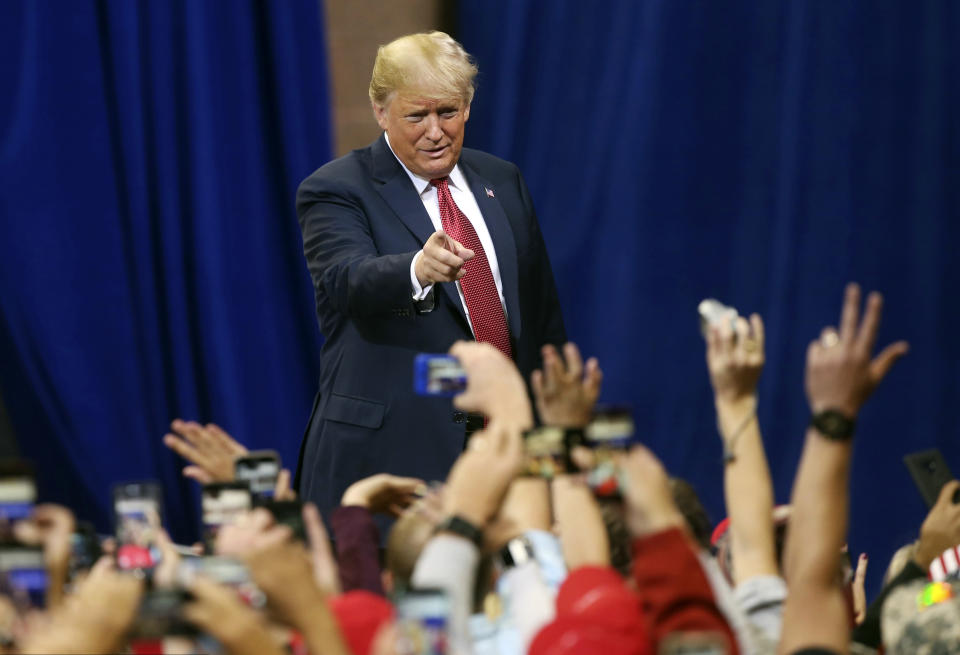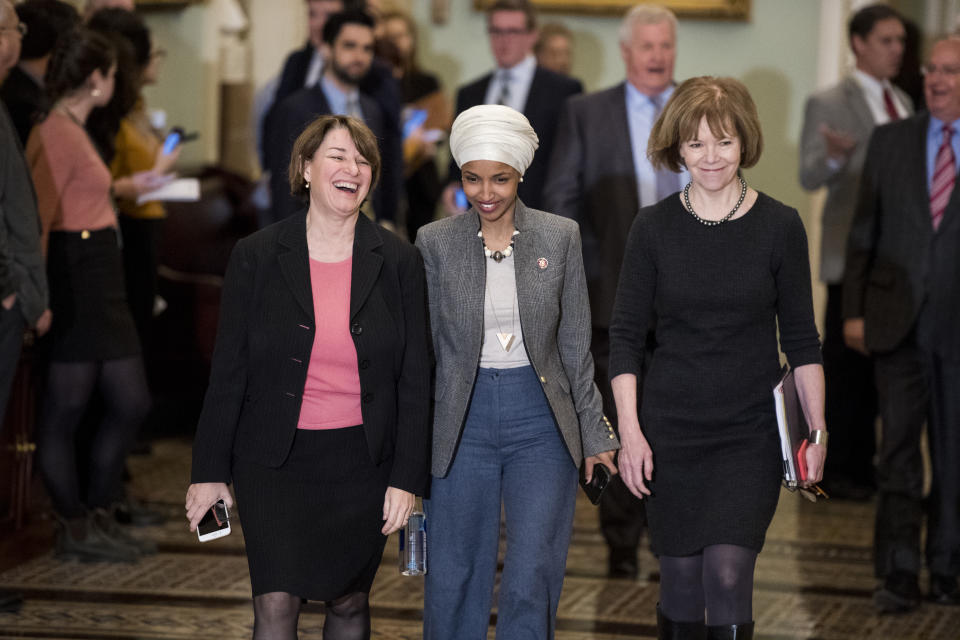2020 Vision Thursday: Trump takes the fight to blue state Minnesota. If he can win there, he's probably unbeatable — but that's a big if.
Welcome to 2020 Vision, the Yahoo News column covering the presidential race with one key takeaway every weekday and a wrap-up each weekend. Reminder: There are 116 days until the Iowa caucuses and 390 days until the 2020 election.
On Thursday evening, President Trump will arrive at Minneapolis’s Target Center for his first political rally since House Democrats began an impeachment investigation. Which raises the question: Why Minnesota?
Because Trump thinks he can win there in 2020.
“[That’s a] state that I’m going to win — Minnesota,” Trump told Turning Point USA in July. “I almost won it last time. We came [within] just about a point. Minnesota is very hard work for a Republican to win. We almost won it — one more night. I wanted to go there one more time. I said, ‘I’m telling you, we’re going to win Minnesota.’”
If Trump were to win Minnesota’s 10 electoral votes, it’s almost impossible to see how a Democrat could defeat him next November. And he’s right: Even though the state is “very hard work” for a Republican — no GOP presidential candidate has carried it since 1972, and no Republican, period, has won a statewide race in 13 years — Trump did, in fact, almost upset Hillary Clinton there in 2016, falling short by just 45,000 votes, or 1.5 percentage points.
So does Trump have a shot? Yes — but only if everything breaks his way.

Working in Trump’s favor is the fact that his campaign is actually investing in Minnesota this time. Last cycle, it spent a meager $30,000 on the state. Now Trump campaign manager Brad Parscale plans to unload “tens of millions of dollars,” according to the New York Times. Already, the campaign has 20 paid staff members on the ground, and it expects to add another 80; along with the Republican National Committee, it’s currently outspending Democrats by about 4 to 1 on digital advertising.
“Over the last 25 years, I’ve never seen an investment as robust and deep this early by a Republican presidential candidate,” the chairman of the Minnesota Democratic-Farmer-Labor Party told the Times. “Trump and the Republicans believe they can win and are doing everything to make it so.”
But believing you can win — and spending heavily to do so — is only half the battle. The problem for Trump is that Minnesota is likely to be more of an uphill fight in 2020, not less. At the start of his presidency, 46 percent of Minnesotans approved of Trump; 43 percent disapproved. But over the last 22 months, his approval rating in Minnesota has plummeted by 14 percentage points; he’s now underwater by 11 points in the state.
The 2018 midterm elections reflected this decline. Sens. Amy Klobuchar and Tina Smith won their races by 24 and 9 points, respectively, and Gov. Tim Walz defeated his Republican opponent by 12 points. Democrats also flipped 18 seats to win control of the state House of Representatives.

Amid the carnage, Republicans saw some signs of hope. In Minnesota’s Seventh Congressional District — an area Trump swept by 31.5 percentage points in 2016 — Democratic Rep. Collin Peterson eked out a slim 4-point victory after clobbering his Republican opponent by 26 points in 2012. Republicans also flipped two U.S. House seats in the rural First and Eighth Districts. The victories were further evidence, they say, that rural Minnesota is trending in Trump’s direction. (In 2016, for instance, he won the Eighth District by 16 points, four years after Barack Obama won it by 6 points.)
But the strategy that drives Trump’s rural gains — unending divide-and-conquer cultural warfare — also weakens his position in the suburbs and exurbs, and it’s unclear that there are enough votes to be had in Minnesota’s northern Iron Range to offset losses in and around Minneapolis, where Trump will rally Thursday. Though Minnesota Republicans flipped two U.S. House seats in 2018, they also lost two in the Twin Cities metro area; overall, Democrats won the statewide House popular vote by nearly 12 percentage points, an 8-point swing from 2016.
There hasn’t been much 2020 polling in Minnesota yet, but the numbers so far hardly suggest that Trump is the favorite. A new survey conducted by Public Policy Polling for a group aligned with Democrats shows that if the election were held today, 52 percent of respondents would vote for an unnamed Democratic candidate; only 42 percent would vote for the president. Meanwhile, in neighboring Wisconsin, a new Fox News poll puts Joe Biden ahead of Trump by 9 points (48-39 percent), with Bernie Sanders besting the president by 5 points (45-40) and Elizabeth Warren leading him by 4 points (45-41). If Trump loses Wisconsin — a more rural, less Democratic state — he’s unlikely to triumph in Minnesota.
So when Trump strides onstage Thursday in Minneapolis, he will likely deliver a full-throated “Make America Great Again” rally, complete with exaggerated crowd figures, denunciations of the media, mocking impersonations of his enemies and boasts about the economy. He will be in the home state of Klobuchar, a candidate running in the Democratic primary to succeed him; of Rep. Ilhan Omar, the fiery progressive he has delighted in skewering; and of Minneapolis Mayor Jacob Frey, who drew Trump’s ire on Twitter by demanding reimbursement in advance for expenses such as police overtime. (The Trump campaign has a reputation for not repaying cities for costs associated with his rallies.)
A few hours later, when Trump leaves the Target Center, presumably to the strains of “You Can’t Always Get What You Want,” he will have given his red-hatted rural voters what they came for. But if what he wants is to carry Minnesota in 2020, “Satisfaction” might be harder to come by.
Download the Yahoo News app to customize your experience.
Read more from Yahoo News:
Greta Thunberg: Powerful men 'want to silence' young climate activists
Driven from Central America by gangs and finding refuge in Kentucky: One woman's story
'I talk about power because you're not supposed to': Why Stacey Abrams still wants to be president
Nation's intelligence officers are resigned to serving a president who doesn't trust them
Before Black Lives Matter: Exhibition pays tribute to an earlier NYPD killing of unarmed black man
360: U.S. pulls support for Syrian Kurds: What happens next?
PHOTOS: Portals to history and conflict — the gates of Jerusalem's Old City





